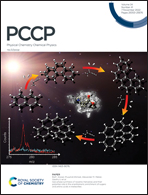Non-adiabatic dynamics in collisions of sodium and chlorine atoms and their ions
Abstract
Collisions of sodium and chlorine atoms and of their ions are studied within the diabatic two-state picture at energies below and above the ionic threshold with focus on the processes of radiative association, chemiionisation, and mutual neutralisation. The radiative-association cross sections as functions of collision energy are calculated up to 4.6 eV in the case of neutral atoms and up to 3.12 eV in the case of ions. The non-radiative charge-exchange cross sections as functions of collision energy are calculated up to 12 eV for chemiionisation and up to 10.52 eV for mutual neutralisation. The corresponding radiative-association rate coefficients are then determined up to 5300 K for the radiative association of neutral atoms and non-radiative charge-exchange and up to 3615 K for the radiative association of ions. Contribution of many Fano–Feshbach-type resonances is included to the rate coefficient of neutral-atom radiative association. The chemiionisation rate coefficients were calculated from 1000 K to 5300 K. The process of mutual neutralisation exhibits the largest cross sections and also the largest rate coefficients with values around 10−9 cm3 s−1 at all calculated temperatures, 120–5300 K.

- This article is part of the themed collection: Festschrift Wolfgang E. Ernst: Electronic & Nuclear Dynamics in Molecules, Clusters, and on Surfaces


 Please wait while we load your content...
Please wait while we load your content...